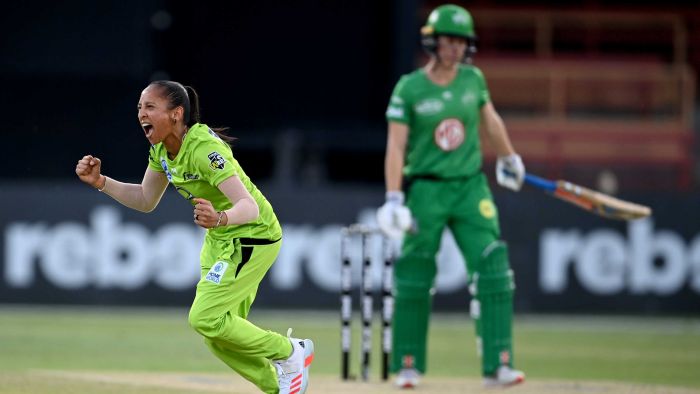The 10cc song Dreadlock Holiday is often used in cricket promotions with the line “I don’t like cricket, I love it!” apparently reflecting a devotion to the summer game.
Usually ignored is that the tourist in Jamaica, who utters the famous line, does so at knifepoint during a mugging and only feigns a love for cricket and reggae to avoid being robbed, or worse.
Yet it turns out — to the apparent surprise of those who have paid hundreds of millions to broadcast the game — you don’t have to put a blade to the throats of Australians to get them to like cricket. Indeed, they still love it.
Last Saturday night, a peak audience of 429,000 watched Sydney Thunder upset Melbourne Stars in the WBBL final, despite Seven’s decision to show the animated movie Frozen on its primary channel and bump the tournament decider to Seven Mate.
But surely after 86,174 turned up at the MCG for this year’s stupendous T20 World Cup final it was apparent young girls were now as enamoured by hard-hitting batters as they are with cartoon princesses?
The WBBL final was sandwiched between — but not overshadowed — by the first two men’s one-day internationals between Australia and India. Those games drew a peak audience of almost 400,000 on Friday night and 448,000 on Sunday (this made it one of the day’s top 10 most-watched programs despite being shown only on pay-per-view TV).
This exclusivity remains a bugbear for those fans who do not have access to Fox Sports or its little cousin Kayo Sports, and who remain understandably aggrieved by the absence of Steve Smith’s eminence and Glenn Maxwell’s almost comedic batting stylings from their screens.
This controversial contractual arrangement brings the possibility that cricket will lose viewers in the long term, as it did in England when the game disappeared from free-to-air screens.
But to put the dilemma in its brightest context for Cricket Australia (CA), the fact potential viewers are complaining that they can’t watch the current ODI series when the 50-over game was supposed to have been usurped by its little brother T20 only emphasises the enduring popularity of international cricket as a whole.
Yet it was only a few weeks ago that it seemed cricket would be broadcast at knifepoint this season with reluctant TV networks attempting to wriggle out of water-tight contracts or demanding considerable discounts.
The obvious assumption was that Seven and Fox Sports were suffering a severe case of buyer’s remorse for their combined six-year $1.182 billion deal and were using the cover of COVID-19 to abandon the game.
Seven’s chief executive James Warburton, particularly, used the blunt instrument of inflammatory and even insulting statements toward CA in order to argue Seven could not have been handed worse content if Australia played a nine-Test series against Angola.
At the same time, the inevitable delay in releasing the summer schedule was weaponised against CA and unflattering comparisons made with the AFL and NRL, which had swiftly agreed to modified rights deals that would ensure revenue flow as they cobbled shortened seasons together.
Never mind that anyone who has so much as tried to read an ICC schedule could tell you putting together a pandemic-era cricket fixture would involve more moving pieces than a Meccano set, and certainly more complexities than any domestic football competition.
And that was without considering the delicate negotiations required to put India’s cricketing princes in quarantine and working out where they could be transported and accommodated and when.
But despite the gloom and doom created by broadcasters who might normally do cartwheels to promote the game, cricket has passed its initial post-COVID tests of televisual popularity with flying colours.
BBL, Tests striving for eyeballs
On December 10, potentially the most contentious element of the cricket viewing schedule arrives, the BBL, a competition which now includes various bells and whistles aimed at maintaining viewer interest over 40 overs, let alone the marathon 61-game season.
But far more than Power Surges, Bash Boosts and hastily recruited imports, perhaps the greatest gift to the BBL is the likely postponement of the Australian Open tennis, which could remove a fearsome rival for eyeballs from the second half of January and hand the sports-minded TV audience to Seven and Fox Sports.




As for the Test series?
An unexpected fear created by two crushing ODI victories is that the Australians might prove dominant this summer, especially with India captain Virat Kohli to leave for paternal duties after the first Test.
Although it should be remembered that almost two decades of ritual humiliations inflicted by the stellar Australian teams of the 1990s and 2000s only got the patriotic juices of local viewers flowing as Shane Warne, the Waugh twins, Glen McGrath and others became daytime TV superstars.
Now Steve Smith’s back-to-back centuries provide the promise of a run-soaked summer, while an injury to opener and part-time selector David Warner only enhances the prospects of a much-anticipated debut by young Victorian prodigy Will Pucovski.
All of which has 10cc’s misunderstood earworm ringing in your head — we don’t like cricket, we love it.
So much so that, if you were a TV executive with the rights to such a popular product, you would surely be happy to put it to air without having a contractual knife held to your throat.







